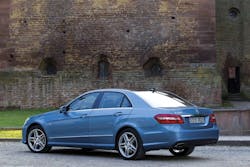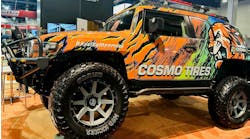It might seem like a stretch to suggest any connection between movie star Johnny Depp and performance touring tires, but I’m going to suggest a few, most notably: range, execution and popularity.
With regard to range, Depp has acted in all types of films: action (“Pirates of the Caribbean”), animated (“Rango”), comedy (“Dark Shadows”), children’s (“Charlie and the Chocolate Factory”) as well as horror, thriller, musical and drama. Performance touring tires work on many types of vehicle segments: executive luxury (Mercedes-Benz E Class), aspirational luxury (Audi A4), premium luxury (BMW 7 Series), midsize (Honda Accord), full-size (Ford Taurus), crossover SUV, compacts, minivans and sport coupes.
With regard to execution, Depp was nominated for three Academy Awards and 10 Golden Globe Awards for bringing to life all types of memorable characters like the iconic Captain Jack Sparrow, Edward Scissorhands, Sweeney Todd and Tarrant Hightopp, the Mad Hatter. Performance touring tires excel in many roles as well. They achieve a high level of balanced performance providing excellent mileage, ride comfort, handling, low noise and often low rolling resistance.
Lastly, Depp’s popularity started to take off in the 1990s, especially with a few critically acclaimed performances late in the decade. But the “Pirates” movies led to a meteoric rise in his box office draw in the 2000s. Along the same time line, performance touring tires started finding OE placement in the ’90s at the original equipment level, with aftermarket options really ramping up in the 2000s.
Tire manufacturers and movie execs alike have realized that performance touring tires and Depp are made of the stuff the public really responds to positively.
Origins of the performance touring tire
The origins of the performance touring tire, like many other newer segments, have their roots set firmly in original equipment. Treads like the Michelin MXV series, Goodyear Eagle, Bridgestone Turanza and Continental TouringContact series shaped the performance touring category, with homologations on many European and Japanese imports in the ’90s. As the auto industry continued to push designs forward, mainstream vehicle wheel diameters grew from 14 inches to 16 inches and above, and speed ratings increased from S and T to H and V. These types of tires were natural OE fitments to replace the broad-line passenger and standard touring tires fitted to previous models.
Wheel diameters continued up to 18 inches and beyond on many luxury vehicles in the 2000s, but I believe the performance touring category took a major step forward in 2007 when the Mercedes-Benz E550 Sport model with 245/40R18 front and 265/35R18 rear tires were fitted with Michelin Pilot HX MXM4 and Pirelli P6 Four Seasons tire options. It was here that Mercedes-Benz made the change from the previous E500 Sport model, switching the tires from Y-rated summer tires to all-season performance touring tires. This was the first time staggered all-season touring tires made their debut on a vehicle. A year later Mercedes-Benz did the same thing with the C300 Sport Sedan with H-rated all-season 225/45R17 front and 245/40R17 rear tires. These two vehicles were the start of a new era for performance touring tires.
[PAGEBREAK]
Aftermarket touring category
Luxury brands like Mercedes-Benz realized that many of their customers were unhappy with the ride quality and mileage of the original equipment tires as the rim diameters grew and the aspect ratios dropped. However, customers still responded positively to the appearance of the vehicles with the larger wheels.
As a result, many models that were previously fitted with ultra-high performance summer tires started getting replaced with performance touring tires. These tires still provided a high level of responsiveness without the harsh ride characteristics or spotty mileage of the performance tires used previously.
The aftermarket was quick to respond at this point, and tread lines that were primarily OE started filling in the size gaps, and new treads started sprouting up from many manufacturers. In 2013, most major brands have at least an OE and aftermarket tread dedicated to the segment, with rim diameters ranging up to 20 inches, aspect ratios ranging down to 35, and mileage warranties as high as 80K.
One of the biggest factors impacting the aftermarket touring category is the range of sizes and speed ratings.
Higher speed ratings and larger rim diameters elevate performance touring over standard touring, and the high diameters and lower profiles overlap with many popular HP and UHP sizes. This brings us to the benefits and challenges of retailing this new segment.
Benefits of retailing
In short, this is a tire that should appeal to a wide range of customers. In the many focus groups I’ve attended, many consumers of mainstream or luxury vehicles used for regular commuting and family transportation reveal they are most comfortable purchasing a tire that performs well in many categories, instead of excelling in one or two.
Although generally not as good in pure handling and braking as high performance tires, performance touring tires are able to mix in higher levels of ride quality and comfort as well as higher mileage than most performance tires. On top of that, these treads often have very comprehensive size coverage, and as discussed earlier, work with many types of vehicles, including crossover SUVs.
Lastly, because the treads often have OE fitments, they are no brainers to stock. Covering the OE and aftermarket segments at the same time is a bonus for inventory levels. Some might say they are as easy to sell as Johnny Depp, but talent comes at a price.
Challenges of retailing
Tires that can do so much so well are bound to command a premium price. The trouble is that different consumers judge value by many different criteria. As much as they value a tire that does a lot well, they also value the dollars in their pockets. Plus for most customers, spending money on tires is as appealing as spending it on a root canal.
Generally, an aftermarket high performance all-season tire is less than an aftermarket performance touring tire, which is less than an OE performance touring tire. So if your sales group is not well informed about the latest products and technologies found in performance touring tires, it might be more difficult to educate the consumer about the reasons the more expensive tire is worth the price.
Additionally, since the performance touring sizes often overlap other segments with similar speed ratings, it can be difficult to make the decision of what sizes to stock in each tread, or which tread should be the “go to” for your sales staff.
[PAGEBREAK]
Solutions and strategies
There is no doubt that a more complicated marketplace favors the more educated and progressive distributor and retailer. So it is in the best interest of a dealer to build a strategy to deal with growing segments like performance touring.
The most comprehensive option is to cover all of the segments in some way, but that is expensive and impractical for smaller distributors. It is not necessary to stock all sizes for all treads, but popular sizes certainly can handle a wider variety of products with minimal risk.
A 225/50R17 can fit everything from a Chevy Malibu (S-rated standard touring) to an Audi A4 (H-rated performance touring) to a Ford Fusion (V-rated performance touring) to a Lexus GS350 (W-rated performance touring). These are all late-model fitment examples, but earlier vehicles have a bigger mix of traditional high performance tires as OE. That is a wide variety of buyers, performance capabilities and price points.
One strategy would be to cover a few popular high-volume OE fitments like the Ford Fusion and Honda Accord and Audi A4; a top tier brand’s performance touring product; a second tier performance touring product; and an entry price high performance all-season tire. To completely cover a size like 225/50R17, you’ll need to look into a summer UHP option and also a run-flat option, as so many of the high-end imports used the size for the last 10 years. This strategy can cover a lot of ground and can be very effective. Add more OE and an extra tier of high performance and you start to give your customers no excuse to leave or shop around.
Some sizes will require more products to be optimal and some sizes will require less. But almost any size that requires a high performance all-season product can benefit by adding a performance touring product.
What does the future hold?
Original equipment continues to support the performance touring segment because the tires are the best option to achieve what OEMs require for many automotive designs. They also give many customers what they desire out of the tires on their vehicles: ride quality, handling and mileage.
Despite the coverage of the performance touring segment, you still have to qualify the customer. Customers that are true performance enthusiasts or have serious budget concerns might not fit the bill. I’ve talked to consumers who thought the UHP summer tires on their BMW 7 Series handled poorly, and I’ve also talked to customers who thought the performance touring tires on their Acura RSX handled poorly.
You have to ask because you never know. But so many other customers will be very impressed with what performance touring tires have to offer.
If you bought stock in Johnny Depp when the “Pirates of the Caribbean” movies kicked off back in 2003, you could be on easy street right now. There’s no denying the drawing power of the versatile and talented actor.
The performance touring tire segment is also versatile and talented, combining customer-friendly benefits and business-friendly revenues.
If you make performance touring tires a big part of your plan, you could move toward your own product screen blockbuster. ■
Robert Abram has worked in the tire industry since 1992, most notably with Dealer Tire LLC and Yokohama Tire Corp. He worked as B2B product manager for Tire Intelligence LLC before recently rejoining Yokohama as product planning manager.



